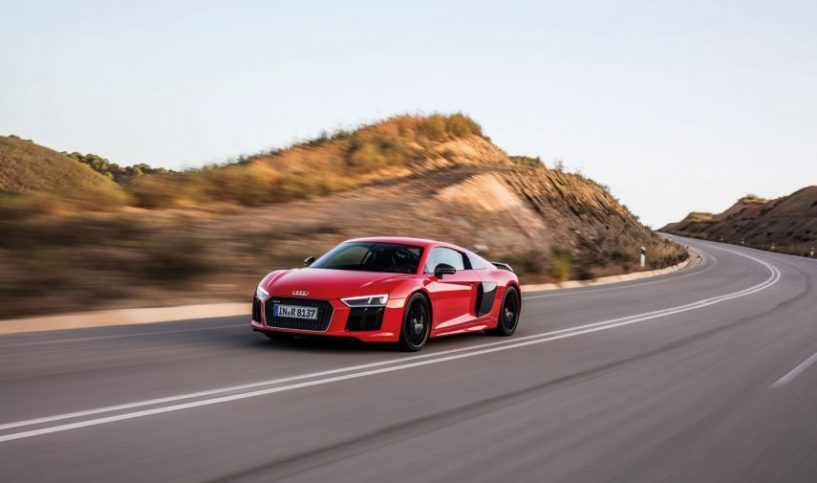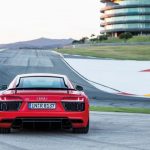The new Audi R8 is the aerodynamic concept of a race car: it is the dynamic vanguard of Audi – no other car with the four rings is so close to car racing. From 0 to 100 km/h in 3.2 seconds, from 0 to 200 km/h, 9.9 seconds and a top speed of 330 km/h. The Audi R8 naturally-aspirated V10 mid-engine thrills with up to 610 hp of power and responds instantly to throttle inputs.
The R8 also enjoyed much success in customer racing: car racing had been a key aspect of its model development from the start. In 2009, the R8 LMS embarked on its career, and by 2014 it had raced to 26 GT3 championships worldwide, 23 other titles and seven overall victories in 24 hour endurance races. Its technology was, and today, in its second generation, still is closely related to that of the road-version sports car.
In the second generation, the road-version sports car and the motorsport version, the R8 LMS, were developed simultaneously for the first time and were presented together at the 2015 Geneva Motor Show. Close cooperation between race car engineers, motorsport specialists and developers has given the new Audi R8 a significant boost in performance.
Named “2016 World Performance Car” in the World Car Awards, the all-new Audi R8 promises tremendous performance and a highly emotional, dynamic drive. The all-new model is available in two engine versions – with the R8 V10 plus being the most powerful and fastest production Audi ever built. The top version 610 hp naturally-aspirated 5.2 liter V10 mid-engine sprints from 0 to 100 km/h in 3.2 seconds, from 0 to 200 km/h in 9.9 seconds and has a governed top speed of 330 km/h. Like a race car engine, it has dry dump lubrication: meaning that its characteristic sound is now even fuller, and a sport exhaust system can be installed as an option. The fuel economy has been improved by up to 13 percent in the R8 model series compared to the previous model.
The mid-mounted engine in the Audi R8 is not only a classic concept in motorsport; it is also an integral part of the brand’s sporty DNA. It was already used in the Grand Prix race cars brought to the starting grid by Auto Union in the 1930s, with the powerful engines located forward of the rear axle – which was a revolutionary step at the time. In the year 2000, Audi won the 24 hours of Le Mans for the first time with the LMP R8 prototype. By 2005, the car which provided the name for today’s high-performance production sports car had taken five overall victories at the Sarthe. It was then retired and replaced by the Audi R10 with a TDI engine.
In the powertrain, the lightning-quick shifts of the seven-speed S tronic dual-clutch transmission, an optimized mechanical differential lock and a new electro hydraulically activated multi-plate clutch work together. The actively cooled all-wheel drive system can distribute torque freely between the axles. The intelligent dynamic control system for the quattro drive is incorporated into the Audi drive select dynamic handling system that offers four basic modes.
In each mode, the new high-performance sports car expresses a different character, from relaxed freeway cruiser to race car on the circuit track. In the top R8 V10 plus model, a performance leather steering wheel is standard equipment.
In its performance mode, it offers three additional modes: dry, wet and snow. They make handling even more precise and sharper, tuned to the friction coefficient of the specific road surface. The new technology is also available on the R8 V10, including the steering wheel that is used to select the special modes.
The new Audi R8 V10 plus has a dry weight of just 1,454 kg. This was primarily due to its newly conceptualized Audi Space Frame (ASF) in multimaterial construction, which consists of aluminum and CFRP parts. The ASF weighs just 200 kg. The entire underbody has a smooth covering, like on a race car, and the air flow exits via a large diffuser. This increases downforce. At top speed, this amounts to 40 kg at the front axle and 100 kg at the rear axle. The large CFRP rear wing also plays an important role in attaining these top figures.
Just like in a race car, the interior of the high-performance sports car focuses on the driver. The driver can read off all key information at a glance from the Audi virtual cockpit. The steering wheel, instrument cluster and road all line up along one central visual axis. Drivers can operate all important functions with the multifunction and satellite push-buttons without having to take their hands off the steering wheel or look away from the road.
The Audi virtual cockpit is user configurable, and it shows all displays in elaborate 3D graphics, if desired, with one large rev counter and auxiliary gages that show much more information, such as tire temperature and torque output. MMI navigation plus with MMI touch is standard equipment in the new R8. This high-end media center was designed to follow a simple operating logic.
The workmanship of the new R8, which is handcrafted at a new plant near Neckarsulm, is superlative. Its range of optional technology components extends to the sound system from Bang & Olufsen and the Audi laser spot, which doubles the range of the high-beam light.
No other production car with the four rings shows as much affinity for the race track as the new R8. This is also proven by its sister models: The new GT3 race car, the Audi R8 LMS. For the first time, Audi developed all two versions simultaneously, in order to optimally exploit synergies. Both the new Audi R8 and its motorsport variant, the R8 LMS, have made significant performance gains, thanks to the close cooperation between race car engineers, motorsport specialists and developers.
One of the top qualities of the new Audi R8 LMS, which is 4.58 meters long and 1.17 meters high, is its aerodynamic efficiency. The large diffuser in the underbody – that is covered by large smooth panels – generates strong downforce, which enables a smaller rear wing. Compared to the previous model, the aerodynamic drag coefficient has been lowered by 20 percent. The flow of cooling air has been improved in all areas, in the front body and in the cockpit.
Today, the new Audi R8 LMS already conforms to GT3 race regulations that take effect in 2016. Just ten weeks after its world premiere at the Geneva Motor Show, the R8 LMS claimed victory at the Nürburgring, making a dazzling entrance on the 24 hour racing scene.
The all-new Audi R8 V10 engine and V10 plus model are now available at Fouad Alghanim & Sons Automotive Company Audi Kuwait showroom. Call the team on 1811 118 or visit them at Shuwaikh Industrial area, Street 11. Find out more online at www.audi-kuwait.com/me.









